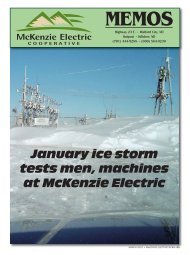Watford City, ND - McKenzie Electric Cooperative, Inc.
Watford City, ND - McKenzie Electric Cooperative, Inc.
Watford City, ND - McKenzie Electric Cooperative, Inc.
Create successful ePaper yourself
Turn your PDF publications into a flip-book with our unique Google optimized e-Paper software.
winter, the clothes were hung until they were frozen and<br />
brought in to thaw and finish drying in the kitchen, basement<br />
or wherever the housewife could find a place to hang them.<br />
Food was cooked over wood or coal ranges and it was constant<br />
work to preserve the food without refrigeration.<br />
The work on the farm continued to depend on non-electric<br />
power well into the 20th century.<br />
The 1920s brought the Great Depression and the drought,<br />
which wiped out many farms. At this point, the future of a<br />
rural electric system seemed almost impossible. The investorowned<br />
power companies continued to insist that the cost of<br />
stretching power lines across rural America was prohibitive.<br />
Some farms did find power in those years. Farms which<br />
were close to town or on direct lines between lucrative<br />
markets might be added to the power companies if the<br />
farmers could meet the price, and many more remote farmers<br />
put in their own power generating sources. These were either<br />
gas motors or wind-charged generators which produced 32<br />
volts of power. The units had a battery system which was<br />
charged by the generator. They were limited in power and<br />
basically provided some lights and a few small appliances.<br />
During those dust- and despair-darkened days of the ’20s<br />
and early ’30s, the promise of power seemed to slip further<br />
from the farms and hamlets of America.<br />
There had been plans aplenty for the electrification of rural<br />
America. Each and every one had floundered and died before<br />
it could come to fruition. In 1935, the recently inaugurated<br />
president of the United States, Franklin D. Roosevelt received<br />
a memo which outlined the whys, wherefores and hows of a<br />
rural electric system. With pressure from various farm<br />
organizations, the decision was made to establish the Rural<br />
Electrification Unit.<br />
The program was seen by Roosevelt and others in Washington,<br />
D.C., as basically a relief<br />
program. It would provide<br />
money to build lines, thus<br />
creating jobs for the unemployed.<br />
The first money for<br />
the program was $100<br />
million from a $5 billion<br />
public works bill.<br />
Within a few months, the<br />
head of the unit, Morris<br />
Cooke, was battling to have<br />
the unit become a separate<br />
agency with permanent<br />
funding. On May 11, 1935,<br />
the president signed an<br />
executive order creating the<br />
Rural Electrification<br />
Administration (REA). After<br />
a pitched battle in Congress,<br />
the Rural Electrification Act<br />
was passed and signed into<br />
law by President Roosevelt<br />
May 21, 1936.<br />
During that time, the form<br />
In 1935 President Franklin D. Roosevelt , signed an executive order<br />
creating the Rural Electrification Administration (REA.<br />
of the REA as a lending institution for rural electric<br />
construction came into being. It was during the first month<br />
that it became clear that the existing power companies were<br />
not interested in bringing electricity to the remote farms,<br />
thinking the cost prohibitive. What those power companies<br />
deemed unfeasible, many hastily formed cooperatives heralded<br />
as their chance for affordable power. Applications for loan<br />
money began to come into Washington, D.C., almost as soon<br />
as the unit was established.<br />
Reading about the new REA in Washington, D.C., were<br />
far-thinking men in <strong>McKenzie</strong> County. Over coffee at the<br />
neighbors and around the stores and elevators, they began<br />
to discuss the possibilities of bringing power to this area.<br />
It would take almost nine years for <strong>McKenzie</strong> <strong>Electric</strong><br />
<strong>Cooperative</strong> to be officially incorporated and almost two<br />
years after that for the first lights to come on, powered by<br />
electricity provided by <strong>McKenzie</strong> <strong>Electric</strong>. But this was the<br />
beginning – a beginning we must not forget.<br />
The 1920s brought the Great Depression and the drought, which wiped out many farms.<br />
SEPTEMBER 2010 • McKENZIE ELECTRIC NEWS—C3<br />
McKENZIE ELECTRIC




